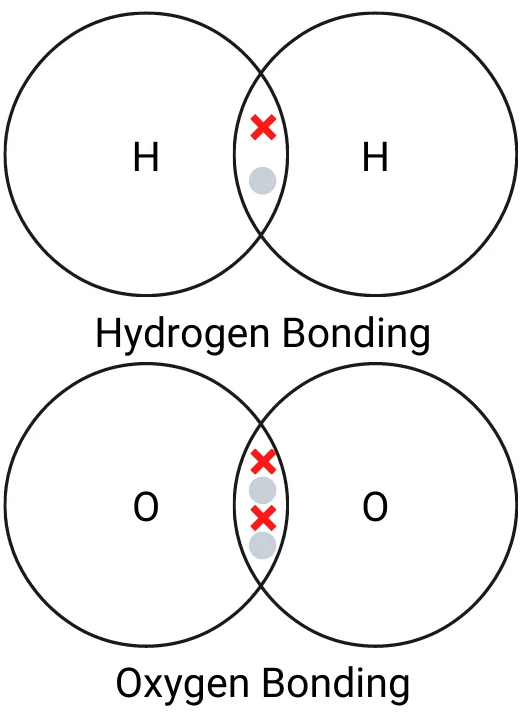Do you know the difference between ionic and covalent bonding?
Covalent Bonding GCSE Quiz
Good Luck!
Covalent Bonding Dot and Cross Diagram
The dot and cross diagram below shows how covalent bonding works in hydrogen and oxygen. Remember, in an exam, they will want you to fill in the rest of the electrons in the outer shell, or perhaps in all of the shells.
Hydrogen has one electron in its outer shell. That means it needs one electron to form a bond. A hydrogen atom forms a single covalent bond, sharing one electron with another hydrogen atom.
Oxygen has 6 electrons in its outer shell. That means it needs two electrons to form a bond. An oxygen atom forms a double covalent bond, sharing two electrons with another oxygen atom.
Learn more about oxygen covalent bonding.
Why is Diamond Hard?

Diamond is hard because each carbon atom has four strong covalent bonds with other carbon atoms, and they are arranged in a tetrahedral pattern which is also very strong.
Why does Graphite Conduct Electricity?
Graphite is made of carbon and each carbon atom has three covalent bonds with other carbon atoms. Each carbon atom can form four covalent bonds meaning there is one delocalised electron that is free to carry a charge and since electrons have a charge of -1, graphite conducts electricity via the one free electron in each carbon atom.
Why is Graphite Soft and Slippery?
Graphite is soft because it is arranged in sheets of carbon atoms, but each sheet is only held together by weak intermolecular bonds. These weak bonds allow sheets of graphite to slide past each other, making graphite soft.
Why does Diamond and Graphite have a High Melting Point?
Both diamond and graphite have high melting points because they are held together by multiple covalent bonds. Each bond requires lots of energy to break and therefore lots of energy is needed to break all of the bonds between carbon atoms. These bonds must be broken in order to melt diamond and graphite, and so, diamond and graphite have high melting points.
How many Covalent Bonds will an Atom of Carbon Form with other Atoms?
Carbon can form 4 covalent bonds since it is in group 4 and it has 4 electrons in its outer shell. For atoms to be stable, they need a full outer shell which for carbon means it needs 8 electrons in its outer shell.
We hope you enjoyed this covalent bonding quiz. Why not have a go at our other bonding quizzes or read up on some of your most common questions? Take a look at the ionic bonding quiz, or the metallic bonding quiz and then finish off your learning with the bonding models quiz.
For more fundamental knowledge, check out the atomic structure quiz and the elements, compounds and mixtures quiz.
